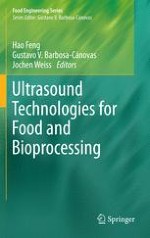2011 | OriginalPaper | Buchkapitel
11. Manothermosonication for Microbial Inactivation
verfasst von : Santiago Condón, Pilar Mañas, Guillermo Cebrián
Erschienen in: Ultrasound Technologies for Food and Bioprocessing
Verlag: Springer New York
Aktivieren Sie unsere intelligente Suche, um passende Fachinhalte oder Patente zu finden.
Wählen Sie Textabschnitte aus um mit Künstlicher Intelligenz passenden Patente zu finden. powered by
Markieren Sie Textabschnitte, um KI-gestützt weitere passende Inhalte zu finden. powered by
